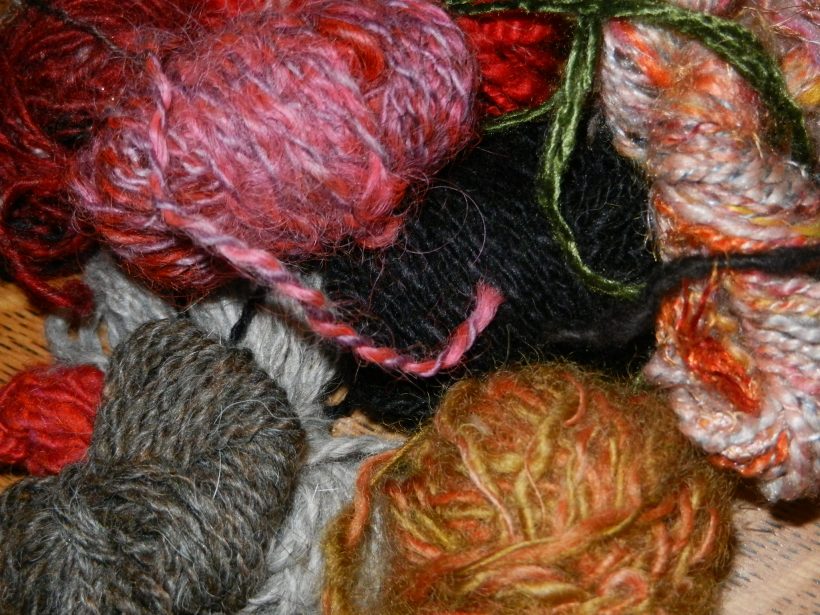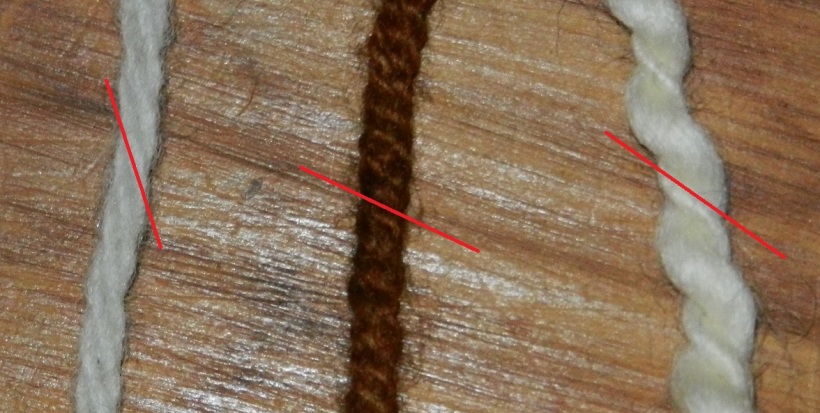Yesterday I got some terrific questions from one of my readers, Susie, over at https://susieshy45.wordpress.com/. She has a down-to-earth blog where she tells stories about her life and practices writing. I particularly like this post: https://susieshy45.wordpress.com/2015/03/29/earth-hour/.
Susie had this to say:
Out of curiosity, where do you get your merino and alpaca wool from? And is it better to use homespun yarn for knitting and crochet?
I answered the first question in the comments of yesterday’s post. The answer to the second question was a discussion, so I thought I’d blast out a post. For me, which kind of yarn I use is a choice based on what my values are for the finished item. For me, it comes down to durability versus cost.
On Durability: A Discussion Unto Itself
Generally speaking, commercial yarns are not as durable as handspun yarns. For instance, weavers tend to not weave with commercial knitting yarn. There’s too much warp breakage; the yarn is too unpredictably behaved. Handspun, on the other hand, is beloved by handweavers, and frequently used as strong, predictable, and beautiful warps.
The durability divide is not that extreme when it comes to knitting and crochet, and it is not an absolute. Handspun generally lasts longer and pills less than commercial, but there are variabilities dependent upon materials, construction, and source. Here are some examples:
- Materials: Merino is a relatively fragile fiber. Silk is very strong. A commercial silk yarn would plausibly wear better and pill less than a handspun Merino.
Construction: The more plies, the longer the yarn will last and the less pilling you will see. This is true for both commercial and handspun yarns, and although I find them beautiful, I tend to steer clear of singles, or unplied yarns, for this reason.
Source: Clara Yarn versus my early crap handspun, for example. Clara’s yarn is commercially made, with a deep knowledge and love of fiber and lots of experimentation to find the optimal twist. Conversely, you couldn’t make me knit with my early handspun.
Below is an example of three yarns, from left to right: a low-twist commercial yarn, a high-twist commercial yarn, and a moderate-twist handspun yarn. Note the deep angle of the twist in the two yarns to the right. These are more durable than the low-twist yarn to the left.
Also, I’m not saying your handspun sweater will last fifty years and your commercial sweater will last three. The gap is not that wide. I’m saying that that durability depends on a lot of factors, and you have to know what they are and make your choices.
Where Does Cost Come In?
A well-made handpun yarn is more expensive than commercial yarn, whether that cost is your money that you use to purchase said yarn, or the materials and time it takes you to make it.
So How Do I Choose?
Funny how one question opens up so many more.
You need to decide where your project falls on the spectrum of durability and cost, decide what is acceptable to you, and choose from what’s available to you. Asking yourself these questions may help:
- How long do you want those socks to last? Are you knitting an heirloom you want to last for one hundred years? A baby sweater that will be worn for six months? How much time will you put into this knitting or crochet project? A lot? A little?
How much money do you want to spend?
What yarns are available to you? Are they plied?
Do commercial yarns or handspun yarns offer you the color choices and/or fiber choices that you are seeking for your project?
How do I know a well-made commercial yarn from a crap handspun?
I could write lengthy posts on these questions and on the subject of durability, and maybe I will, but the short answer is that the more knowledge and experience you have with yarns, the better you can judge what is crap, what to drool over, and when you want to use which, because it is not an either/or answer, but a weighing of priorities.
The less verbose answer is, while there is a divide between the durability of handspun and commercial yarns, most projects do not warrant the high cost of handspun, and commercial yarns will work anywhere from just fine to beautifully.

Gratuitous yarn photo. Note the orangy ball at the bottom with the gawd-awful loose twist. An early handspun.
I encourage you to attend fiber festivals and events and study the yarns. Fondle, sniff, and ask questions. Find some handspun, knit with it, and see how you like it. The texture of handspun yarn is very different from most commercial yarns. It is less smooth and regular, more textural. I am besotted with it.
Check out Knitter’s Review for reviews of well-made commercial yarns. Clara Parkes is well known for her in-depth and trustworthy reviews, and is one of my major sources of textile lore.
***
OK, dudes, this is really long, and it’s really late. I’m going to knock off now. Susie, I promise to get to your other question in the next few days. Thanks so much for commenting and asking!
c.lou



April 1, 2015 at 2:10 am
Lou,
Thank you for explaining in such detail. Where I live, there is absolutely no one who makes or sells homespun yarn- I would need to get it online.
Thanks for the resources too. Another question if you don’t mind- do you make homespun yarn with a machine or by hand and if by machine, are these machines costly and where are they available ?
LikeLike
April 1, 2015 at 7:40 am
I usually spin it on a spinning wheel, but it can be made with a hand-held drop spindle. An entry-level wheel runs anywhere from $300-$800 or so; nicer machines can cost in the thousands. You can buy them online, but it’s best to take some lessons and test-drive several wheels so you have an idea what works for you and what you like before you invest. Wheels come in a variety of makes and models, and there are educated choices to be made. BUT! You can make a drop spindle for a few bucks, or pick up a relatively inexpensive one online or at a fiber event. Google “make a drop spindle” and see what you find. I found a drop spindle easier to learn on. Once I began to handle fiber somewhat capably, I moved on to a wheel.
Abby Franquemont’s “Respect the Spindle” is a good DVD from which to learn to spin. It’s an acquired skill, but very rewarding. Thanks for asking!
LikeLike
April 1, 2015 at 11:46 am
And another thought: Abby Franquemont’s blog, http://abbysyarns.com/, is a great place to learn more about spinning, both on a wheel and on a spindle. I’ve learned a lot from her over the years. I suggest going into her archives and starting at the beginning, though, because the last few years of her life have been HAIRY and she’s posted more about that than spinning. Not that you shouldn’t read her personal content too. She’s had a fascinating life, and she’s articulate and intelligent and funny; it’s just easier to absorb taken in context.
LikeLiked by 1 person
April 3, 2015 at 12:03 am
Awesome post!! Could I include a clipping from your post on my blog, or actually a zine about handspinning? And I’d link back to yours of course! Or maybe I should reblog it? The site is thedraftingzone.com Thanks!!
LikeLike
April 3, 2015 at 9:22 am
Of course! Feel free to use a bit of content or reblog, as you wish. (: So glad you liked it. I had fun writing it. At first it was twice as long, but I was like, Curvy, you need to make this digestible, so I totally chopped it. I may expand on various elements at a later date.
LikeLiked by 1 person
April 3, 2015 at 3:24 pm
Oh that is cool! I will keep an eye out for it! I’d like to curate topics together and I’m gathering info on this idea of commercial + handspun. So! That will be in June I think! Sounds so far off~~
LikeLike
April 3, 2015 at 5:05 pm
Ah ha, I see! Interesting topic, I agree. I like your idea of topical curation, and look forward to seeing your blog grow. (:
LikeLiked by 1 person